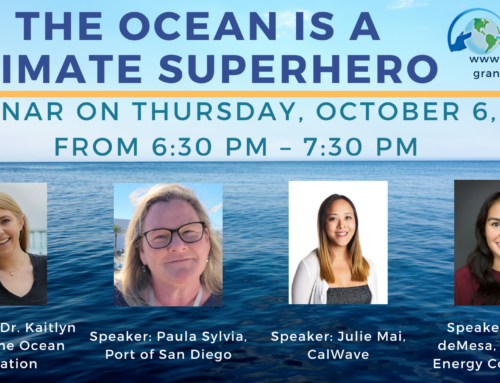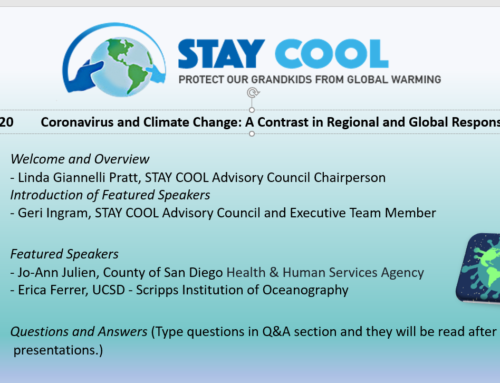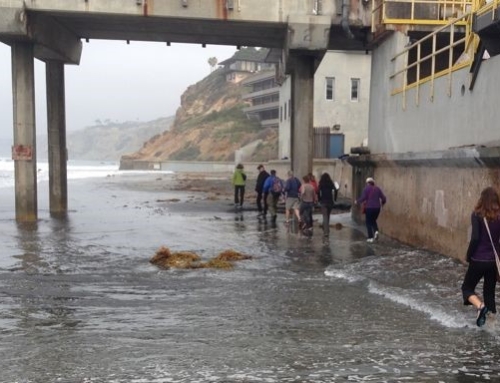Meeting Notes from July 15, 2014 STAY COOL Member Meeting
We welcomed 25 guests at this meeting held in Del Mar at the Engel home.
Emily Young gave an update on The San Diego Foundation’s Focus 2050 report. It is a follow-up report to the first of its kind assessment of climate change for the San Diego region. The report examines how we can help prepare our region for climate change and what we can expect by 2050. Some key findings include:
• In the next 40 years, San Diego temperatures are expected to increase more than twice as fast as they have in the past 40 years. We will see more days of extreme high temps with longer and more frequent heat waves and less nighttime cooling.
• Our water demand will increase by a projected 46 percent by 2035 but scientists are expecting a 12 percent decrease in our water supply.
• By 2050 we could experience 5 to 24 inches of sea level rise. The 1-in-100-year coastal flood will perhaps occur every year.
• The number of homes lost annually to wildfires has doubled since before 2000. In the future, we are looking at hotter and drier climate which will increase the frequency and severity fires; also resulting in more poor air quality days.
Download or read the Focus 2050 report here.
Jim Stone from Circulate San Diego presented background about Circulate and the San Diego General Plan called San Diego Forward. Click here to view Jim’s presentation: CirculateSD Presentation for Stay Cool July 2014.
• The mission of CirculateSD is to create excellent mobility choices and vibrant, healthy neighborhoods. It resulted as a merger of WalkSanDiego and Move San Diego just four months ago.
• In San Diego, 46% of our carbon emissions come from transportation. The community’s Sustainable Communities Strategy (SCS) aims to reduce emissions from land use and transportation. It should better connect new housing and jobs with transportation alternatives. By locating housing and jobs closer to transit lines and in walkable communities, we will reduce emissions.
• Walking and biking to destinations is the most economical choice, and comes with positive public health outcomes that have an indirect economic impact as well.
• The region’s population is expected to grow by about 1,000,000 people by 2050 and that the economy anticipates there will be 500,000 additional jobs. A key question is how and where do we locate all those people and all those jobs to maximize a sustainable future?
• To accommodate a million new residents, our region is projected to develop about 350,000 housing units between now and 2050. However, we only have about 4% of our land as developable space. Future growth will happen in existing neighborhoods, as compact infill development.
• In San Diego in 2011 the first statewide SCS was adopted. The Air Resources Board set the targets for SANDAG GHG reductions 7% in 2020, and 13% in 2035. SANDAG showed it could meet these goals, but the GHG numbers backslid when modeled to 2050.
• The main components of the SCS include: compact land use, increased transportation choices, transportation demand management, transportation system management and pricing policies.
• AB 32 required CA GHG emissions to 1990 levels by 2020, and Schwarzenegger’s S-305 calls for 80% below 1990 levels by 2050. To achieve this, it will require huge changes in energy storage and consumption patterns, in addition to the Land use and transportation changes.
• SANDAG is trying to achieve these goals through the 2011 plan actions:
- Allocated $2.58 Billion for Active Transportation (over 40 years), with $200 M in first decade
- Conserved 50% of Region for Open Space
- 80% of new growth planned within ½ mile of transit
- Adds 156 new miles of light rail
- Adopted Policy Commitments including: transit oriented development, complete streets and safe routes.
• SANDAG is currently in the development plan phase of the 2015 RTP San Diego Forward.
How can STAY COOL members get involved and become agents of change?
• You can get involved now in the San Diego Forward involvement process. They need to hear the voice of citizens who support transit, smart growth and transit oriented development. All too often, they only hear the “NIMBYs”.
• For example, during this process, Circulate was successful in getting health into the equation.
• Be specific when making asks of SANDAG. Circulate asked for early action funding for Active Transportation and SANDAG changed it to Bike Master Plan only.
• Remember, politics matters. Get community group members together (bike coalitions, grandparents, church groups, etc.) and take them to meet with a member of SANDAG board. Educate them about what matters in the general plan. Should elected officials there is support for smarter choices. We must develop political champions for infill, (in addition to Active transportation) to be successful.
• Stay engaged with the San Diego Forward process. Attend the mobility workshop on August 4. Learn more here: https://sdforward.com/sites/sandag/files/Alternative%20Scenarios%20Workshop%20Flyer_FINAL2.pdf
Laura Schumacher with the San Diego Unified Council of PTAs shared their efforts to advance climate change education in our schools.
• The council is taking up a resolution for the California State PTA to consider climate change a children’s issue and urge its councils to advocate for climate change action. Click here to view the resolution PDF: PTAClimateChangeResolutionDraft.
• If anyone has any suggestions to improve our resolution or make it more scientifically accurate, please contact Laura and she will share all feedback with the Resolution Study Committee.
• Laura needs support from the scientific community and is looking for a scientific advisor. Contact Laura at lauras@san.rr.com.
• When they submit the Resolution to the State Resolution Committee in the fall, a letter of support from STAY COOL would be helpful – what could be better than a coalition of PTA parents and grandparents!?! Stay tuned for more information about how to help.
In STAY COOL member news:
• Review and sign our member declaration to receive a STAY COOL T-shirt. Our declaration is a statement of our concerns and hopes for our children and grandchildren in the face of climate change. It represents our ideals and desire to prepare for and help mitigate against the negative effects of climate change. View it here.
• Volunteers are needed to attend and represent SC4G at the Environment Committee (Formerly Natural Resources and Culture) meeting on Wednesday July 23 at 2 pm. View the agenda here: https://docs.sandiego.gov/ccagenda_enviro/enviro140723.pdf
• Help the County better plan for severe heat events due to climate change. Complete the San Diego County OES online survey and include the following point, “Severe heat events and threats to public health due to climate change and global warming should be taken into consideration.” The 5-minute survey can be found here: https://www.surveymonkey.com/s/ZPYGVG6
Save the date for our next meeting on Wednesday, September 24 featuring Charles Kennel, a past director of Scripps Institution of Oceanography (SIO).



